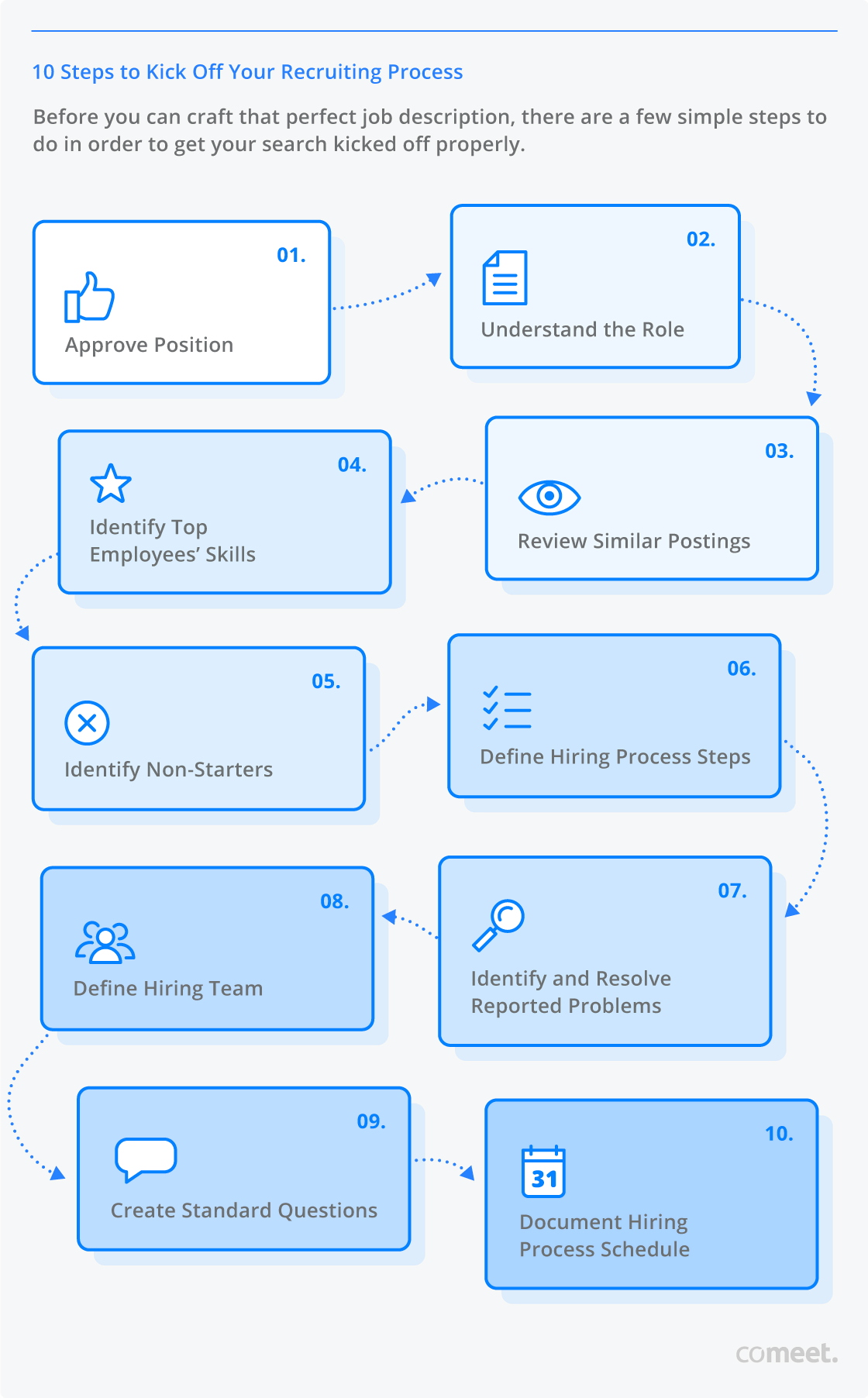Your company’s growing fast, and the project backlog is building. You know you need to expand the team, hiring that new engineer or marketing manager or sales rep. Whether you’re the hiring manager or recruiting manager, you figure the first thing you have to do is sit down and put together a job description to get things rolling on the hiring front.
Well, when you’re ready to do that, we’ve covered how to write a compelling job description for you. But first, there are a few things to do before you sit down and start crafting it. Whether you’re an in-house recruiter or the actual hiring manager recruiting for the role yourself, the process is the same (though if you’re the hiring manager, some of these steps simply involve your carefully defining things yourself).
Let’s look at the steps you should follow to get your job recruiting search kicked off properly.
This is part of an extensive series of guides about workforce management.
Step 1 – Approve Position
Before you get started, make sure the position’s been approved, salary is budgeted and you’re ready to go. Nothing sours a candidate’s view of your company and harms your employer brand – leading to a poor recruiting reputation that impacts all your recruiting efforts – than finding out at the end of the process that you can’t proceed. Having to “put our search on hold” or being forced to offer up any other excuse for not moving forward can prove incredibly harmful in addition to being a waste of time and resources.
Step 2 – Understand the Role
Engage with the hiring manager to understand all aspects of the role. You don’t want to rely solely on job description templates and standard job position descriptions. Only by working closely with the hiring manager (or doing so yourself) will you understand all the nuances of the role, its unique characteristics and what makes it appealing to the top candidates.
Step 3 – Review Similar Postings
See how the top candidates in your space recruit and describe their positions. Like any other ‘product’ you’re selling, you need to attract the best buyers (i.e., candidates) to your opportunity. By reviewing similar type of positions elsewhere, you’ll get a good feel for how they position their companies and opportunities. You don’t want to simply copy what you see, but like performing any competitive analysis, doing so will help you understand how best to differentiate the unique characteristics that you’re offering.
Step 4 – Identify Top Employees’ Skills
Understand what makes your best employees, your best employees! Spend some time to identify the characteristics, skill sets, values and experience that your best performers have. While you certainly want to build a diverse workforce with different perspectives, there are likely particularly characteristics that you’ll find are most successful in your particular company. Identifying what these are ahead of time will help you zero in on those candidates that can bring their own take on those characteristics to the table, and turn into future top performers!
Step 5 – Identify Non-Starters
Correspondingly, get agreement on what your non-starters on. Likely, through experience, sometimes painful experience, you can identify what are the types of candidates that just won’t work for you. Knowing what these are from the start saves everyone time (both candidates and your hiring team) if you know in all likelihood, they’ll not make it through the process (and worse, if they did, would likely lead to problems going forward).
Step 6 – Define Hiring Process Steps
Define your recruiting & hiring process. You don’t want to be figuring it out in the midst of conversations as it inevitably leads to your dropping the ball, being inconsistent from candidate to candidate and presenting a poor impression of an unorganized company from the start. This doesn’t mean you have to have the same steps for each role (phone screens, in-person interviews, exercises, presentations, etc.). Your process for an experienced Senior Account Executive doesn’t need to be the same as a rookie Sales Development Rep (SDR). What’s crucial is that you have the process and each of the steps defined, and agreed by everyone involved in the hiring process. And most importantly, make sure your recruiting and hiring technology platform enables collaboration by everyone involved, for your particular process.
Step 7 – Identify and Resolve Reported Problems
Examine your company’s reviews on sites like Glassdoor. This is often a first stop for candidates before deciding to apply, so you want to make sure you identify any prior problems reported in your hiring process so you can both reply on the site and as importantly, remedy any flaws in your process that may have been pointed out by prior candidates.
Step 8 – Define Hiring Team
Define the team that’ll be involved and lock down the necessary time commitments from everyone. Before the submissions start rolling in, it’s important to understand who’ll be responsible for each step in the process. Make sure you know who’s responsible, either solely or part of a dedicated team to:
- Identify all the candidate sourcing channels to use and manage postings
- Review all submissions for consideration
- Serve as the point person to candidates
- Manage all communications and schedules
- Outreach to desired, passive candidates
- Perform initial phone screens
- Perform first round interviews
- Perform second round interviews
- Review any exercises or presentations
- Perform reference checks
- Respond to all interviewed candidates
- Make offer(s)
Your applicant tracking systems should facilitate and automate all these steps, from assignment to scheduling to communication to assessment.
Step 9 – Create Standard Questions
Put together a standard set of questions for each interviewer to ensure a consistent interview process from candidate to candidate. Having your interviewers ‘freelance’ during each candidate interview makes it difficult to objectively review candidates against each other and can inadvertently introduce biases into the hiring process.
Step 10 – Document the Hiring Process and Schedule
Put together a timeline of how you want your recruiting process to proceed. You don’t have to have hard deadlines (“we’re going to hire the best person we see by the end of the month, regardless”) but you should put together a schedule to both
- Enable all participants in the process to plan accordingly and allocate their time, as well as
- Keep you on track so the process does have an endpoint and doesn’t go on forever.
With all these steps properly documented and executed, you’re then in the best position to ensure a successful recruiting & hiring process. As always, putting in a little bit of effort up front will least to a vastly better process for candidates, recruiters and hiring managers.
See Our Additional Guides on Key Workforce Management Topics
Together with our content partners, we have authored in-depth guides on several other topics that can also be useful as you explore the world of workforce management.
HR Technology
- How Your ATS System Can Protect Your Company From Liability
- 10 Signs Your Startup Needs a Recruiting Solution
- 5 Different Types of Recruiting Software
What is Onboarding
Authored by Hibob
- Four Onboarding Best Practices
- Successful Employee Onboarding Process + Checklists & Templates
- Remote Onboarding: the Complete Guide
Full Time Equivalent
Authored by Stoke
- What Does Full Time Equivalent Mean, and Why is it Important?
- How Do I Complete an FTE Calculation for My Business?






























